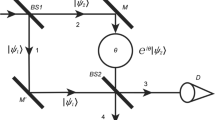Abstract
Shahriar S. Afshar claimed that his 2007 modified version of the double-slit experiment violates complementarity (Afshar et al. in Found Phys 37:295–305, 2007). He makes two modifications to the standard double-slit experiment. First, he adds a wire grid that is placed in between the slits and the screen at locations of interference minima. The second modification is to place a converging lens just after the wire grid. The idea is that the wire grid implies the existence of interference minima (wave-like behavior), while the lens can simultaneously obtain which-way information (particle-like behavior). More recently, Cramer (The quantum handshake: entanglement, nonlocality, and transactions, Springer, Berlin, 2016) argued that the experiment bolstered the Transactional Interpretation of Quantum mechanics (TIQM). His argument scrutinizes Bohr’s complementarity in favor of TIQM. We analyze this experiment by simulation using the path integral formulation of quantum mechanics (Feynman in Rev Mod Phys 20367–20387, 1948) and find that it agrees with the wave-particle duality relation given by Englert, Greenberg and Yasin (E–G–Y) (Englert in Phys Rev Lett 77:2154, 1996; Greenberger and Yasin in Phys Lett A 128:391–394, 1988). We conclude that the use of Afshar’s experiment to provide a testbed for quantum mechanical interpretations is limited.





Similar content being viewed by others
Data Availability
Data and code are available upon request.
Notes
Note that in this example with point like sources, a simplified definition of D is used (Eq. 1). When inserting the wires, the complete form is needed and is used for our calculations: \(D = |P_{1,1}-P_{2,1}|+|P_{1,2}-P_{2,2}|\) where \(P_{i,j}\) is the probability to detect at detector i following path j [9]
The simulation code can be found at https://git.unl.edu/bgergely/simulation-of-afshar-experiment
In the simulation, the integral of Eq. (3) becomes a sum over a finite number of grid points between the slit (or wire grid) boundaries.
References
Afshar, S.S., Flores, E., McDonald, K.F., et al.: Paradox in wave-particle duality. Found. Phys. 37, 295–305 (2007)
Englert, B.-G.: Fringe Visibility and Which-Way Information: an Inequality. Phys. Rev. Lett. 77, 2154 (1996)
Greenberger, D.M., Yasin, A.: Simultaneous wave and particle knowledge in a neutron interferometer. Phys. Lett. A 128, 391–394 (1988)
Qureshi, T.: Modified two-slit experiments and complementarity. J. Quantum Inf. Sci. 2(2), 35–40 (2012)
Steuernagel, O.: Afshar’s experiment does not show a violation of complementarity. Found. Phys. 37, 1370–1385 (2007)
Katzner, R.E.: On visibility in the Afshar two-slit experiment. Found. Phys. 39, 1139–1144 (2009)
Flores, E.V., De Tata, J.M.: Complementarity paradox solved: surprising consequences. Found. Phys. 40, 1731–1743 (2010)
Reitzner, D.: Comment on Afshar’s experiments (2007). arXiv:quant-ph/0701152
Jacques, V., et al.: Illustration of quantum complementarity using single photons interfering on a grating. N. J. Phys. 10 (2008)
Cramer, J.G.: The Quantum Handshake: Entanglement, Nonlocality, and Transactions. Springer, Berlin, pp. 111–112 (2016)
Feynman, R.P.: Space-time approach to non-relativistic quantum mechanics. Rev. Mod. Phys. 20367–20387 (1948)
Cronin, A.D., Schmiedmayer, J., Pritchard, D.E.: Optics and interferometry with atoms and molecules. Rev. Mod. Phys. 811051-129 (2009)
Jones, E.R., Bach, R., Batelaan, H.: Path integrals, matter waves, and the double slit. Eur. J. Phys. 36(6) (2015)
Jakob, M., Bergou, J.: Quantitative complementarity relations in bipartite systems: entanglement as a physical reality. Opt. Commun. 2154 (2010)
Reis, M., Oliveira, A.C.: A complementary resource relation of concurrence and roughness for a two Qubits State (2021). arXiv:2106.00036
Basso, M.L., Maziero, J.: Predictability as a quantum resource (2021). arXiv:2107.13468
Fonseca-Romero, K.M., de Oliveira Jr., J.G.G., de Faria, J.G.P., Nemes, M.C.: Interference and which-state information for nonorthogonal states. Phys. Rev. A 90, 062102 (2014)
Gustavo de Souza, G., de Oliveira Jr., J.G.G., Varizi, A.D., Nogueira, E.C., Sampaio, M.D.: Open-quantum-systems approach to complementarity in neutral-kaon interferometry. Phys. Rev. A 94, 062108 (2016)
Georgiev, D., Bello, L., Carm, A., Cohen, E.: One-particle and two-particle visibilities in bipartite entangled Gaussian states. Phys. Rev. A 103, 062211 (2021)
Jacques, V., et al. Delayed-choice test of quantum complementarity with interfering single photons. PRL (2008)
Flores, E.V.: Reply to comments of steuernagel on the Afshar’s experiment. Found Phys 38, 778–781 (2008)
Bohr, N.: Discussions with Einstein on Epistemological Problems in Atomic Physics. The Library of Living Philosophers (1949)
Wikipedia, Transactional interpretation. https://en.wikipedia.org/wiki/Transactional_interpretation, (2020)
Acknowledgements
We gratefully acknowledge support by the National Science Foundation (NSF) under the Award Number PHY-1912504.
Author information
Authors and Affiliations
Corresponding author
Ethics declarations
Conflict of interest
The authors declare no conflict of interests.
Additional information
Publisher's Note
Springer Nature remains neutral with regard to jurisdictional claims in published maps and institutional affiliations.
Rights and permissions
About this article
Cite this article
Gergely, B., Batelaan, H. Simulation of Afshar’s Double Slit Experiment. Found Phys 52, 69 (2022). https://doi.org/10.1007/s10701-022-00585-7
Received:
Accepted:
Published:
DOI: https://doi.org/10.1007/s10701-022-00585-7




